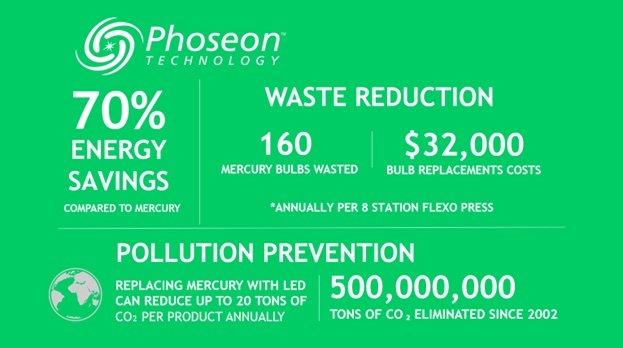Phoseon Technology: Factors that Contribute to Return on Investment for UV LED Curing Technology
UV LED curing technology is being adopted rapidly by converters and becoming the new standard for UV printing because the advantages are so significant compared to traditional mercury UV. Here are some of the factors that contribute to return on investment:
Higher yields due to consistent, reliable curing
Increased press up-time due to instant on/off technology
Low maintenance (no reflectors, shutters, or bulbs)
Faster throughput
Reduce shipping costs with lighter, thinner materials
Energy savings of 50% to 85%
Save money without the need to stock replacement parts
No disposal costs for mercury bulbs
Lower operating costs with no external exhaust blowers
Increased Productivity
UV LED curing solutions bring higher profits through increased press uptime, scrap reduction with increased yields, and overall increased productivity compared to mercury UV. Due to the long wavelengths, UV LED products have the ability to cure difficult inks with better adhesion and higher print quality at faster speeds.
Mercury systems need to be running all the time, while LED is instant on off and can be used as needed. With mercury there is a lot of heat to manage, stray light, components that deteriorate over time, and a very short lifetime. In contrast, LED brings stability and has a very long lifetime.
Process Stability and Long Lifetime
The long life and reliable output of UV LED lamps provides consistent cure and process stability. This translates into improved up-time and predictability of cure which benefits all who are involved. Since UV curing issues on press are typically the result of a faulty mercury lamps, the formulation, or the converting process, the use of UV LED technology eliminates the UV curing system as the source of the problem. This saves time in troubleshooting and ultimately has a positive impact on the bottom line. UV LED opens the door to new revenue opportunities with the ability to print on heat-sensitive and thinner substrates, offering increased profitability for printers and converters.
No Bulb Replacements
Conventional mercury lamps have a very short lifetime and need to be replaced every 1,000-1,500 hours. UV LED curing lamps extend beyond 60,000 hours, if maintained properly. Upgrading to UV LED technology eliminates these replacement costs, offering significant environmental benefits with the elimination of mercury.
Energy Savings
UV LED curing products provide significant energy savings compared to mercury UV. With traditional UV curing processes, the tremendous heat associated with mercury UV lamps require a significant amount of electricity to operate. UV LED technologies provide energy savings up to 85 percent compared to traditional mercury-vapor UV lamps.
Phoseon recently visited a label converter in Europe with eight printing presses and learned that one third of the entire energy consumption of the factory is attributed to the mercury lamps on the presses. Today the energy prices have tripled in some places, so printers have become very eager to install LED on the press to replace the mercury. Upgrading to UV LED curing can reduce energy bills by 50-85% overnight with return on investment in well under one year.
A Phoseon customer in Italy experienced more than 70% energy savings by upgrading from traditional mercury UV to Phoseon Nexus ONE™ UV LED curing systems for flexographic printing. According to the customer, an 8-color UV flexographic press (430mm wide) that
works on 2 shifts and consumes an average of 198,000kWh per year with traditional mercury UV. Under the same conditions, consumption with Phoseon UV LED is 58,000kWh. The annual
saving for a single machine is therefore 140,000kWh x € 0.20 (average energy price per kWh in Italy) = € 28,000, to which are added to approximately € 10,000 of spare parts/ consumables for a total saving of approximately € 38,000 per year.
Sustainability has risen on the agenda, but the power consumption brings the economic aspect to the table. The economics are driving this change, and at the end of the day the economics are the biggest driver for change. In the past, making the sustainability changes was typically more expensive. But today it is possible to meet the economic targets and increase the sustainability initiatives at the same time.




